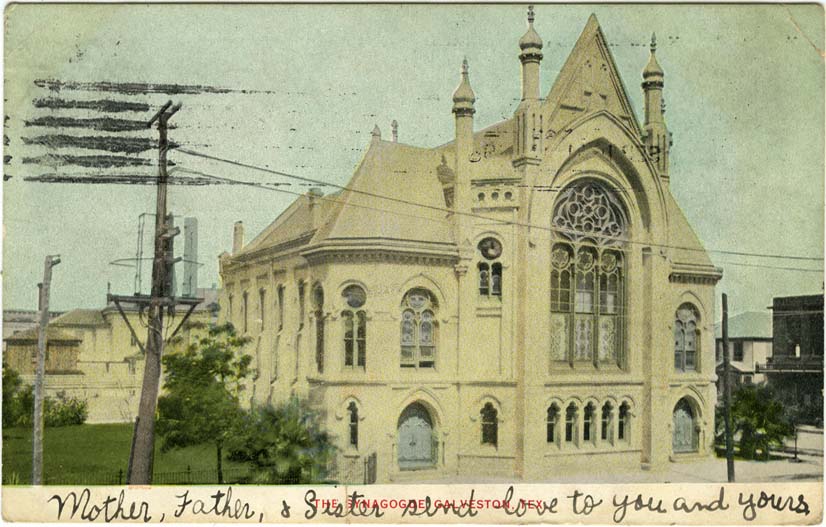2.1 Galveston, Texas
B’nai Israel, 822 22nd Street
Fred Stewart, architect, 1870; remodeled by Nicholas Clayton, 1886–87
Publisher and publication date unknown
This card shows one of the oldest standing synagogues in Texas. Aside from the building’s significance for its mix of Gothic and Moorish elements, it is important as the spiritual launching point for thousands of Jewish immigrants who passed through Galveston from 1907 to 1914, en route to resettlement across the Midwest and West as part of the Galveston Movement.
The synagogue was designed by local architect Fred Stewart and built in 1870. The Galveston News reported about the building at great length in 1871, at the time of the dedication, providing one of the most detailed descriptions of a synagogue interior of the time:
It is most substantially built of brick, with stone finishings. It presents a handsome exterior, in which the perpendicular Gothic style prevails. . . . The interior consists of two stories, the principal one and the basement, the latter being fitted up for use as a school. You ascend to the main hall by a handsome flight of steps decorated with two ornamented pillar lamps and enter a small vestibule, paved with encaustic tiles; from thence opens the House of God, of which an inscription in Hebrew on the building reminds you with the words “This is the Gate of God, where the pious enter.”
The open doors disclose a most pleasing and handsomely decorated interior, with a gallery along three sides. The supports are managed with a rare mechanical skill, as there are no pillars to obstruct the view or occupy room. Passing along the main aisle you find the reading desk, beyond that still another to be used for exhortation and prayer. These desks are very handsomely made, and are admirably adapted to their uses. Behind these, in a recess in the eastern wall [is] the place for the deposit of the scrolls of the law. This is hidden by two magnificent silk velvet curtains, of a rich maroon color, splendidly embroidered with gold bullion. In the centre of them appears a royal crown with these words in Hebrew below: “The Crown of the Lord.” The crown is supported by two lions, in commemoration of the lions on the throne of Solomon. Below them, in English, appears an inscription: “Given by the Ladies of the Congregation B’nai Israel.” And truly, it was a royal gift.
The desks are covered with the same costly material, sumptuously ornamented with the gold fringe, which are also the ladies’ gift. The floor is covered with a very handsome and expensive carpet, and is occupied with five rows of seats. These are grained in oak, are convenient and look well. . . . The galleries—that on the west is occupied by the choir and organ—are finished in the same color, and are well arranged. The building is lofty, well lighted, and at either end are handsome octagonal windows, filled with richly stained glass. Above the recess for the reception of the scrolls, the Decalogue is seen carved in the wall in Hebrew characters in gold. Beneath them appears also in gold characters in the same language, signifying the admonitory words, “Know before whom thou standest.”
The article correctly describes the style as Gothic, but the architect had also included a few elements of the then–in vogue Moorish style, such as horseshoe arches.
Galveston had a well-established Jewish community before the Civil War. B’nai Israel (Sons of Israel) was the second Jewish congregation to be founded in Texas, and the first Reform congregation to be chartered in the state. In 1875, it became a charter member of the Union of American Hebrew Congregations (UAHC), the national body of Reform Judaism. By the 1880s, the congregation had grown and already needed a bigger synagogue. Around 1887, architect Nicholas J. Clayton rebuilt and expanded the old synagogue, but to what extent is not fully known; it is unclear which parts of the building visible in the postcard image date from 1870 and which from 1887.
Beginning in 1888, Rabbi Henry Cohen led the congregation for more than five decades. He rallied members to care for others after the devastating hurricane of 1900, and founded the Galveston Movement, a program that operated between 1907 and 1914 to resettle Eastern European Jewish immigrants through the port of Galveston.
The synagogue served the congregation until 1955 when it was sold to a Masonic lodge and the congregation moved to a new building at 3008 Avenue O designed by congregant and Holocaust survivor Tibor Beerman (1925–2015).
